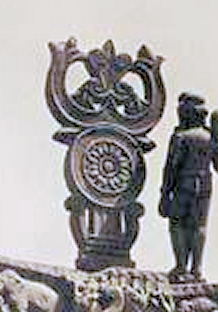Three jewels

The three jewels ( Pāḷi : Tiratana, Skt . : Triratna ; also: three precious stones , triple precious stones , three treasures ) designate in Buddhism Buddha , Dharma (the Buddha-doctrine) and Sangha (here, depending on the school, is usually only the This refers to the community of the awakened, in some schools also the general sangha, which includes the practitioner in their entirety). For the Buddhist they are the objects of the triple refuge . It is only through taking refuge in the 'Three Jewels', out of deepest inner conviction, that someone is considered a Buddhist.
Creed
The traditional formula in Pali is:
|
Buddham saraṇam gacchami |
I take refuge in Buddha |
It is spoken three times in a row, as was the custom in ancient India as a sign of complete conviction.
During the ceremony of first refuge in the community, the practitioner usually also undertakes to observe the Five Silas , the moral rules of Buddhists.
In Mahayana Buddhism, the Uttara Tantra Shastra (Tibetan rgyud bla ma ) by Maitreya / Asanga is the basic work on the 'Three Jewels'.
See also
literature
- Arya Maitreya, Khenpo Tsultrim, Gyamtso Rinpoche: Buddha Nature: The Mahayana Uttaratantra Shastra. Snow Lion Publications, Ithaca 2000, ISBN 1-55939-128-6 .
Web links
- Tribute to the three treasures (p. 4–5; PDF file; 92 kB); a sutra of refuge
supporting documents
- ↑ The Diversity of Buddhist Knowledge - The Buddha - The Teaching - The Community. (PDF; 10 kB) (No longer available online.) German Buddhist Union , archived from the original on December 18, 2013 ; Retrieved January 24, 2011 . Info: The archive link was inserted automatically and has not yet been checked. Please check the original and archive link according to the instructions and then remove this notice.
- ↑ Shakyamuni Buddha. Retrieved January 24, 2011 .
